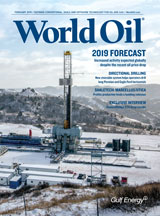Issue: February 2019
Special Focus
Worldwide E&P expenditures should grow 8% during 2019. North America’s uptick will continue, but at a slower rate, while international activity should energize the OFS sector.
In the November 2018 mid-term elections, all 435 seats in the House of Representatives, 35 Senate seats, and 36 governorships were contested.
Over the last 12 months, the global upstream industry has featured rising oil and gas production; volatile, unpredictable oil prices, as evidenced in the last three months; and in the U.S., slowly-but-steadily rising drilling activity.
With crude prices rising during the first nine months of 2018, the U.S. rig count grew steadily, as production cuts by OPEC+ kept the shale plays humming.
Unrelenting activity in the U.S. shale plays pushed oil production up to 11.58 MMbpd in November, making the U.S. the world’s largest petroleum producer, surpassing Russia and Saudi Arabia.
Stronger oil and natural gas prices, combined with continuing development of shales and low-permeability formations, generated new all-time record levels of proved reserves for both fuels in 2017.
Rising oil supplies and falling prices in second-half 2018 constrained global drilling, but activity should post a measured gain in 2019. Virtually all the global oil production increase is due to U.S. shale activity.
A year ago, things appeared to be looking up for Canada’s oil patch, but that proved unfounded. In early 2019, more uncertainty and pessimism are in the air, and little on the horizon provides hope for improvement.
Features
We have just left a transformational year in the industry, where shifting commodity prices and evolving drilling strategies have demanded agile thinking and ingenuity—especially in the oilfield services and equipment sector.
A novel rotary steerable system addresses maintenance, downhole motors, and hole geometry in a new light.
In an exclusive interview with World Oil Editor-in-Chief Kurt Abraham, ConocoPhillips Chief Technology Officer Greg Leveille discusses the technical issues facing global E&P, particularly as relates to the many U.S. unconventional plays
A cooperative thermometer has lost favor as the primary gauge for measuring the economic winds of the gas-rich Appalachian basin.
The Eastern Mediterranean Gas Conference (EMGC) is gearing up for another must-attend event in Cyprus.
To navigate continually changing HPHT design and regulatory requirements, a collaborative approach is required. The team is qualifying a 20,000-psi rated BOP. Engineers are hopeful that the HPHT design process will reach the same level of standardization as today’s 15,000-psi equipment, after completion of this and similar qualification efforts.
For years, Australia’s overall production rate has been shrinking. However, according to the U.S. EIA, additional production from new condensate and crude oil developments is expected to offset the decline over the next few years.
The oil and gas industry relies heavily on external workers, in the field and in the office. A recent survey of senior oil and gas executives shows how the external workforce is sourced, managed and deployed—and how it adds value.
Columns
The art of discussing issues in 2019
The status of airguns and alternatives
Is your top drive healthy?
Well organization
Russia’s development and the disconnect between oil prices and exchange rates
The Great Water Hope: The future of oilfield produced water
U.S. inches closer to energy independence
News & Resources
The Huizhou 32-5 oil field comprehensive adjustment/Huizhou 33-1 oil field joint development project reportedly started production.
Crude continued to recover in January after OPEC’s production cuts began to influence prices.
Equinor and its partners have started production from Aasta Hansteen gas field in the Norwegian Sea.



